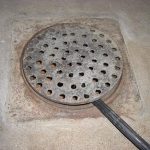Deep cleaning travertine floors can be a daunting task, but it is necessary to maintain the beauty and longevity of your floors. As someone who has had travertine floors for years, I have learned a few tricks to make the process easier and more effective. In this article, I will share my tips and techniques for deep cleaning travertine floors.
Travertine is a natural stone that is porous and prone to staining, so it is important to use the right cleaning products and techniques to avoid damaging the surface. Regular cleaning with a damp mop or cloth is essential to keep the floors looking their best, but deep cleaning is necessary to remove dirt and grime that has built up over time. Deep cleaning should be done every few months, depending on the amount of foot traffic and use the floors get.
In this article, I will cover the essential steps for deep cleaning travertine floors, including preparing the floor, choosing the right cleaning products, and using the correct techniques to avoid damaging the surface. Whether you are a seasoned homeowner or a new travertine floor owner, my tips and tricks will help you achieve a deep clean that will leave your floors looking beautiful and new.
Gathering Supplies
Before deep cleaning your travertine floors, it’s essential to gather all the necessary supplies. Here’s what I recommend:
- A soft-bristled broom or vacuum cleaner with a hard floor attachment to remove loose dirt and debris.
- A dust mop or microfiber cloth to wipe away any remaining dust.
- A pH-neutral cleaner specifically designed for natural stone floors.
- A bucket to mix the cleaning solution.
- A mop with a microfiber head or a soft-bristled brush to apply the cleaning solution.
- A clean, dry towel or mop to dry the floor after cleaning.
- Protective gloves to keep your hands safe from any harsh chemicals in the cleaning solution.
It’s important to note that steam cleaning is not recommended for travertine floors as the high temperature and moisture can damage the stone. Stick to using a pH-neutral cleaner and avoid any acidic or abrasive cleaners that can etch or scratch the surface of the stone.
Once you have all the necessary supplies, you’re ready to start deep cleaning your travertine floors.
Preparing the Floor
Before deep cleaning your travertine floors, it is important to prepare the surface properly. This will help to ensure that the cleaning process is as effective as possible.
The first step in preparing the floor is to remove any loose dirt and debris. You can do this by sweeping the floor with a soft-bristled broom or using a vacuum cleaner with a soft brush attachment. Be sure to pay extra attention to the corners and edges of the room, where dirt and debris tend to accumulate.
Once you have removed the loose dirt and debris, it is time to give the floor a thorough cleaning. You can use a mild cleaning solution specifically designed for travertine floors, or you can make your own solution by mixing warm water with a few drops of dish soap. Be sure to test the solution on a small, inconspicuous area of the floor first to make sure it does not cause any damage.
Next, use a soft mop or cloth to apply the cleaning solution to the floor. Be sure to wring out the mop or cloth well so that it is only slightly damp. Excess water can cause damage to the travertine surface.
Finally, allow the floor to air dry completely before walking on it. This will help to prevent any water spots or damage to the surface.
It is important to note that steam cleaning is not recommended for travertine floors. The high temperatures and moisture can cause damage to the surface of the stone. Stick to using a mild cleaning solution and a soft mop or cloth for best results.
Deep Cleaning the Travertine Floors
When it comes to deep cleaning travertine floors, there are a few steps you can take to ensure they are thoroughly cleaned without causing any damage. One important thing to keep in mind is that travertine is a natural stone and can be sensitive to harsh chemicals, so it’s best to use a pH-neutral cleaner.
First, start by sweeping or vacuuming the floor to remove any loose dirt and debris. Next, mix a cleaning solution of warm water and a pH-neutral cleaner according to the instructions on the label. Dip a mop into the solution and wring it out thoroughly.
Then, mop the floor in sections, making sure to rinse the mop frequently in the cleaning solution. Be sure not to leave any excess water on the floor, as this can cause water spots or damage to the stone.
If you want to disinfect the floor, you can add a few drops of essential oil or vinegar to the cleaning solution. However, be careful not to use too much, as this can damage the stone.
Can you steam clean travertine floors? Yes, you can, but it’s important to use a steam mop that is specifically designed for use on stone floors. These types of steam mops use very little water, which helps to prevent any damage to the stone.
Finally, after mopping, dry the floor thoroughly with a clean, dry mop or towel. This will help to prevent any water spots or damage to the stone.
By following these steps, you can deep clean your travertine floors without causing any damage and keep them looking their best for years to come.
Rinsing and Drying the Floor
After cleaning the travertine floor, it is important to rinse it thoroughly to remove any remaining cleaning solution or dirt. Use a clean mop and fresh water to rinse the floor. Make sure to change the water frequently to avoid spreading dirt around.
Once you have finished rinsing the floor, it is time to dry it. Use a clean, dry towel or mop to remove any excess water. Make sure to dry the floor completely to avoid water spots or damage to the travertine surface.
It is important to note that steam cleaning is not recommended for travertine floors. The high temperature and pressure of steam can damage the surface of the stone and cause it to crack or discolor. Stick to using a mild cleaning solution and water for best results.
Sealing the Travertine Floors
After deep cleaning your travertine floors, it is important to seal them to protect them from future damage. Sealing the floors will help prevent stains and scratches from everyday wear and tear. It is recommended to seal your travertine floors at least once a year.
Before applying the sealer, make sure the floors are completely dry and free of any debris. If there is any moisture trapped deep in the travertine, applying the sealer may not be as effective. You can use a dry mop or vacuum to ensure the floors are clean and dry.
There are different types of sealers available for travertine floors, including water-based and solvent-based sealers. It is important to choose the right sealer for your specific type of travertine. You can consult with a professional or read the manufacturer’s instructions to determine the best sealer for your floors.
When applying the sealer, make sure to follow the manufacturer’s instructions carefully. It is important to apply the sealer evenly and thoroughly to ensure complete coverage. You can use a paint roller or brush to apply the sealer, depending on the size of the area you are covering.
After applying the sealer, allow it to dry completely before walking on the floors or placing any furniture back on them. It is recommended to wait at least 24 hours before using the floors again.
It is important to note that steam cleaning is not recommended for travertine floors. The high heat and moisture from steam cleaning can damage the floors and cause them to discolor or crack. Instead, use a mild cleaning solution and a soft mop to clean your travertine floors.




